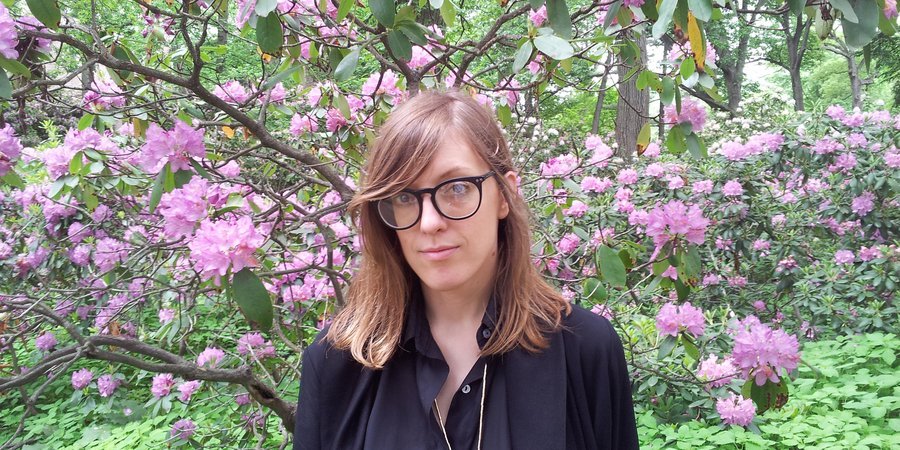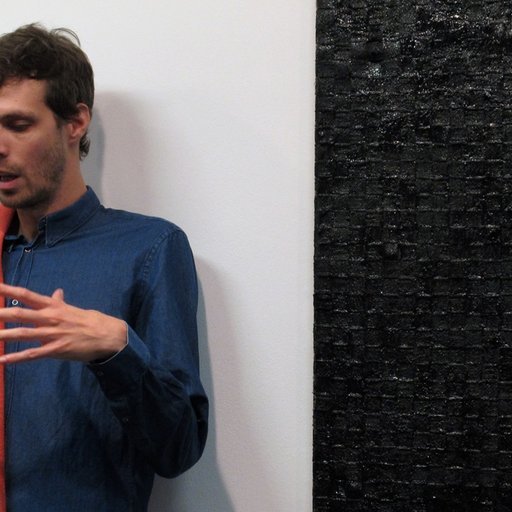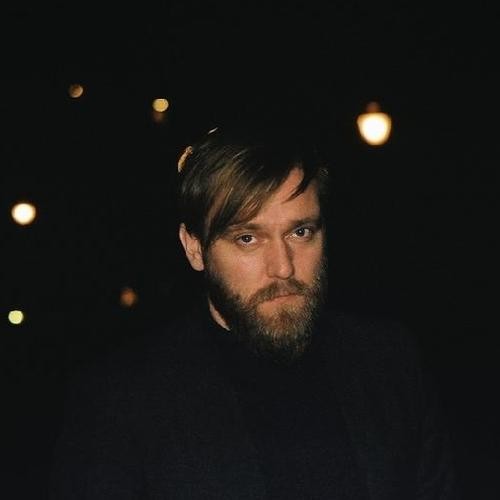Another theme present in my work is how humans make the same personal or artistic discoveries over and over. People are always repeatedly doing the same thing and thinking it’s new when it really isn't at all, but the surrounding context is always changing, so actions take on new meanings. I feel connected to human history when I’m working with those images, like there’s a line through time connecting moments when people stumble onto the same idea or artists create the same image. If time was a two-way street and people from the beginnings of civilization could equally reflect on our time, the present would be alienating yet familiar to them, just like it is for us when we look at ancient art.
It’s possible to discern Greco-Roman imagery in your work, but also possibly that of the Egyptians and other cultures. Where do you find your inspirations for these elements?
Religious and spiritual imagery is kind of a scrap heap of basic symbols that are shared by many belief systems. You can mix up all the symbols, and they can continue to have meaning because they all relate to these fundamental polarities of good and evil, masculine and feminine, light and dark. In classical, primitive, or even scientific imagery, you can find all the same stuff. I thought about this more in a different body of work from a while ago, but my personal visual language was kind of fixed at that point, so it retains a lot of allusions to basic forms of spiritual or classical symbolism. My work keeps becoming more reductive because I try to find the baselines that join a lot of human and cultural experiences.
Your works also recall iconic works of Modern art history, from the Bauhaus to Matisse and Picasso. How do you see the ancient and the Modern as coexisting, and what relevance do they have to the contemporary world?
My work is often seen as Modernist because it’s reductive, graphic, and primitive. But I’m not a formalist. My work can also be humorous, ironic, and personal. Sometimes that’s because of the imagery, and sometimes those are qualities that are just inherent in the rawness of my materials. Modernism is half imposed rational order and half primitivism, and it will always be about a return to something basic. Inherent in all of that is that the idea of going all the way back to square one, to this ancient, freer way of being, while at the same time, we progress into the future, towards an ideal that we could potentially embody. Unfortunately, we are so temporally fixed in the present, and so Modernism in the early 20th century embodied the patriarchal and unequal society of which it was a product. The clash between stark rationality and primitivism is something that I let play out a little more loosely in my work instead of trying to find a place where they fit together.
You make many references to dance in your work, and even when you don’t explicitly show a dancer, the abstract motifs of your work imply movement. Why does dance play such an integral role in your work?
I’ve always liked working with explicitly figurative or anthropomorphic images and shapes, and dance is a beautiful way to arrange those shapes. Dance and theater represent two mediums with which I can visually experiment using people's bodies, costuming, and set design. Sometime in the last few years, I wanted to exclusively make drawings for a while, and there were motifs that came to the surface in my practice that I could use to just riff off in an effort to move through making a lot of work. Vases were one—a decorative yet symbolic object whose form could endure endless redesigning. Dancers were another. Dance and theater became a mental space where I could make more formal explorations. It's all so visual and full of movement, and in a way, it's even like drawing. I also love dance music, and I don't make music, but I DJ a lot.
You tackle your signature motifs in both painting and sculpture. How do these two mediums relate in your work, and what is your process in transitioning from an idea to a finished piece?
When I make a sculpture, it usually has its source in a drawing somewhere. I often mine my own work for things to do again slightly differently, or even, in some cases, not differently at all. And my cement sculptures, despite their large size and weight, have the presence of drawings. They often have fronts and backs, like they’re cut out of the two-dimensional world and given thickness. I’ve been working on paper for much longer than I’ve been working with sculptures, and sculpture is a slower process of discovery for me just because it involves more materials and process and waiting. Whereas I was making sculptural work more incidentally a couple of years ago when I was focused more on drawing, now I’m dealing with painting, sculpture, and drawing in really similar ways, with a lot of information flowing back and forth.
Who are some of the artists who have inspired you the most?
In 2012, Modern Painters included you in their annual list of the “Top 100 Painters to Watch.” Then, this year, Halsey McKay Gallery brought your work to NADA NYC for a solo display of your Motifs series. How does it feel to have suddenly gained such a spotlight for your work?
It's great! These are really wonderful things to happen, and I’m grateful for the positive attention.
You began your career by making paper cutouts assembled from old books that you then arranged into totems. The cutouts were striking for their surreal, colorful content, and yet now you’ve moved on to your Motifs, which are equally striking for their reductive color palette. What inspired you to make such a dramatic stylistic change?
All those early collages were me trying to do the same thing I do now, just with a less defined concept. I got a lot more serious as I kept working. The Motifs gave me more control, and then simultaneously, I was also given more freedom in minimalism. I also started trying to work a lot faster. It was all just an effort to try to focus on what was really going on in my work and get rid of all the extra stuff. I also just wanted people to like my work for the reasons that I was making it instead of for what color it was or something that was going on in it that was more frivolous; I wanted to attempt to narrow that divide by just making it a lot clearer. I got everything down to a really simple system and stayed there for a long time, which helped me to really connect with what I was doing. Lately, I've been interested in returning to more complex work that uses different materials and a more complex process. It feels really good to go back to where I started.
In 2009, you and Joshua Smith organized the traveling “Apartment Show” series, in which you exhibited art in homes, galleries, and even MoMA PS1. Can you talk a little about what you and Smith were doing with this project?
Joshua and I started "Apartment Show" because we were angry and desperate. We wanted to define for ourselves what exactly was going on in that moment in late 2008—our first show was in January 2009—when the world was falling apart. The art world didn't seem to be lining up with all the financial trouble in many other industries, and we wanted to explore that. The danger of being left behind by a system that we were all so invested in as it grew ever richer, echoing the woes of investors and homeowners, was disheartening. It was made even worse by seeing the style of business at the top trickle down to the smaller galleries and emerging artists, who were trying to make these calculated moves to avoid any risk.
Ultimately, "Apartment Show" wasn’t an attempt to get people to recognize the reality of the situation we were all living in, or even to solve any problems, except that maybe everybody might be taking themselves too seriously. So we created an event that had a premise so thin and redundant and already done, with an organizing style that was almost automatic, that allowed participating artists the freedom to do whatever they wanted to do. And I think people really appreciated that opportunity, because while apartment art shows and galleries have always happened—which is why we simply called it "Apartment Show," an old idea in itself—there weren’t a lot of things like it happening at that time. I’ll also say that both of us made our living then by working for artists and galleries, and we were happy that the money was there so that we could do that. Our intentions were never to save it or create something that represented a purer or better model. We just kind of wanted to do something ourselves that was fun, where there was no budget and where artists got the chance to relax.
For me, it was one of the best things I ever did. While we got to do this punk thing that got attention and inspired a lot of people, it’s also how I became a part of this solid community of artists that I feel so much support from to this day. I’m pretty sure that a lot of other people feel the same way. And it was super cool to do a show at PS1.
What was your first significant art experience?
I just found a report I did on Mary Cassatt in third grade in which I reproduced some of her paintings in pencil, and I think that’s the first time I remember really looking at a piece of art, if only very literally. I also had a little crafts table in the basement of our townhouse when I was little where I would mostly make clay palm trees. I would paint anything that I could find, these muddy, swirly paint interventions into anything that was around, which drove my mom crazy.
What made you want to become an artist?
I grew up in the suburbs, and while there are skilled artists and craftsmen in my family, there are no career artists. So while I’ve always had support and encouragement from my family, I had no examples of someone living the kind of life that I currently live as a working artist in the city. It took a long time to realize what it meant to be an artist. I’m still trying to define it.
Is there anything you collect yourself?
I’m a terrible art collector. My friends are much better at collecting than I am. I try not to hang on to stuff too much, although I feel like I’m finally settling down a bit, so maybe I’ll finally try to build an art collection. My boyfriend collects these really cool porcelain dishes and vases, so I can help with that a little.
What are you working on now?
I’ve got some shows coming up, one at Cooper Cole in Toronto that I’m really excited about, and I have some other things a little further away. Essex Flowers, the Lower East Side basement art space, opened in June, so eight other artists and I will be working on things there. And I’m trying to squeeze in a little summer vacation here and there.
























